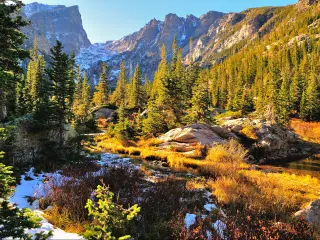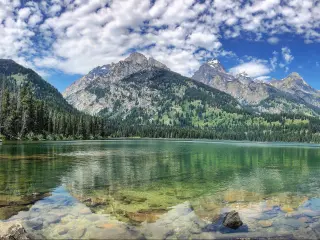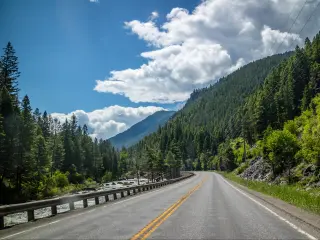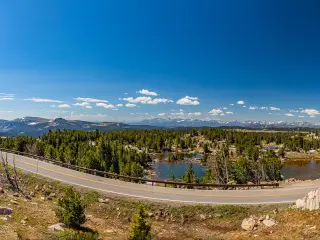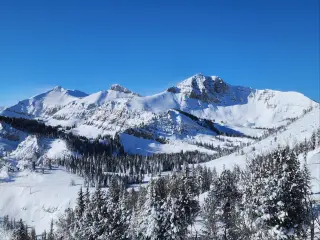Driving in Wyoming - Driving advice, rules and requirements
If you are visiting Wyoming and want to drive around the state or if you are already in the Cowboy State and want to learn more about the rules of the road and get some helpful hints about driving, we've got a guide that should help you out!
Driving in Wyoming is relatively straight-forward as long as you follow the local rules and make sure your car is prepared for the difficult terrain and weather you may come across on your way. Make sure your documents are in order and you're good to go!
Take note - this guide is primarily aimed at people visiting Wyoming and key information, such as essential things to know about driving, focuses on major differences to other states or countries.
Contents
Useful things to know about driving in Wyoming
If you're coming to Wyoming from other states, here's a few things you should know that may be different to what you're used to:
- No toll roads - there are no toll roads at all in Wyoming. The only times you need to pay while driving is when you enter the various local, State and National Parks or other places that charge an entrance fee.
- Some remote roads can be hard to pass - some of Wyoming's remote roads are unpaved and may be difficult to drive in anything other than an appropriate SUV or truck with all wheel drive.
- Studded tires are legal - Wyoming is one of very few states where studded tires are legal (but not mandatory) in the winter. This means that some vehicles around you might be able to steer much better and stop much more quickly than you - keep plenty of distance and take extra care.
- Some unusual local laws can apply although you are unlikely to come across a situation you'll need to obey one of these. For example, if you're traveling over a small rural road and come across a gate, you are legally obliged to shut the gate behind you or risk facing a $750 fine!
Rest areas and gas stations
Although much of the state is remote, there are plenty of gas stations around that sell diesel and gas. As Wyoming has a high average elevation, the state's standard gas comes in 85, 88 and 91 octane for standard, mid-range and premium gas.
This means that if your car requires premium fuel of 93 octane or higher (equivalent to 98 RON in other countries around the world), you will have to settle for the lower octane premium fuel - the high elevation will most likely mean you won't notice much of a difference.
There are official rest areas and places to stop along the Interstates and major routes but as Wyoming has so much open space and is very rural, you will find places to stop almost anywhere if you need to have a short break, make a call or eat. Restaurants, restrooms and other facilities are usually only going to be found in towns along the way.
What to do in an emergency
If you are in a serious emergency and are in need of urgent police, medical or the fire department help, dial 911. If you can't dial or are out of signal, see if any other road users will help you out or dial from the nearest town or place with cell coverage.
If you get into an accident, remember to stay calm and follow the following basic steps:
- If possible, find a safe place to stop off the highway.
- Provide any medical assistance necessary to people in your vehicle, any other vehicles involved, pedestrians or other people involved. In Wyoming this is a legal requirement so do what you can to help!
- If emergency services are required, dial 911.
- If the accident is in any way serious (damage total of over $1,000), you must report it to the local police who will come and complete their paperwork.
- Exchange contact details and insurance with any other parties, take any photos or other information/evidence down for when you need it later on.
Driving license and other paperwork
In order to drive in Wyoming, you need to have a valid driving license, registration and insurance for the vehicle that you are driving. If you get stopped by a police officer or are involved in an accident, you are likely to be required to produce all 3 of these on demand.
Make sure you carry all of these with you whenever you drive the car. While it is not a serious offense, you can create a lot of headache for yourself and waste a lot of time if you happen to not have the documents on you when requested. If you do hold a valid driving license and insurance, you will be able to produce these later on to avoid a penalty, but you are also likely to waste a lot of time by the roadside and may even have to go to a police station.
| Document | Requirements |
|---|---|
| Driving license Mandatory | Valid license from your state/country |
| International Driving Permit Recommended | 1949 Convention format - can make things much easier if you get stopped, especially if your license is not in English |
| Passport Recommended | Not strictly necessary but can make it easier if you get stopped for identity confirmation |
| Vehicle registration Mandatory | Either your vehicle's registration or car rental paperwork |
| Insurance Mandatory | Insurance for you driving the vehicle that is valid in Wyoming |
Driving license requirements
If you do not have a Wyoming driving license, all you need to have is a valid driving license from your home state. Take note that if you are moving to Wyoming, you will have to switch to a Wyoming license within a year, but all visitors and students can drive on their home state license.
If you are visiting from another country, you can drive using your country's license as long as it is valid in your country. Technically you do not need an International Driving Permit in Wyoming, but I would highly recommend you go and get one. This is especially true if your license is in any language other than English or if you come from a country the local police may be a little less familiar with.
You will need to get yourself an International Driving Permit (IDP) that adheres to the 1949 Geneva Convention - be careful as there are 3 different types you can get! You can only get the IDP in the country in which the license was issued and you will usually be able to pick them up in places like your local post office for a nominal price - usually a few dollars' equivalent.
I'd much prefer to take the 5 minutes it takes to get one of these to the headache of discussing the legalities of whether you need it at the roadside in rural Wyoming with a police officer who has never previously seen your kind of driving license and has no idea if it is genuine.
If you are renting a car, the paperwork your car rental company will give you should have what you need for the registration and insurance components. If driving your own car, make sure your insurance is valid in Wyoming and the United States in general and if not, buy an additional policy to cover your car.
Other paperwork to have in the car
There are two other mandatory documents that you must have when driving a car. These are the vehicle registration and insurance confirmation documents.
A police officer can request to see these documents if you are stopped as you are driving and failure to produce them can not only make it awkward but result in a lot of wasted time, a potential visit to a police station and a fine.
The vehicle registration is simply the original document that confirms you own the car that is valid in your state or country. If for whatever reason your registration document is not from the United States or Canada, I would strongly recommend getting a legally certified translation that also prescribes the key terms typically found in a U.S. registration from the different parts of the original document.
Insurance is a relatively simple one - your car has to have valid insurance for you driving it at the time you're driving. If you are driving from Canada or elsewhere outside the United States, check to make sure your insurance covers you in the United States. If you are visiting from another state and not staying for over 90 days, your insurance policy should be good for Wyoming but you might want to check to make sure.
For those from outside the United States, a passport is highly recommended. A police officer has the legal power to confirm the identity of the driver and a foreign driving license together with the handwritten IDP document may not satisfy this requirement for them.
Again - I'm not providing legal advice on what is technically correct here. I'm just saying you should bring your passport to save you potentially wasting a lot of time and nerves if you do get stopped.
Driving in Wyoming: Rules of the Road
Safety laws and rules you need to know
Although most of the rules for driving in Wyoming are the same as the rest of the United States and similar to other countries around the world, there are a few differences where each state seems to have a slightly different way of doing things.
Can you turn right on a red signal? What is that sign I've never seen before? Can I go in this lane? Here's what you need to know!
- In Wyoming the default rule is that you can turn right on a red signal as long as you have stopped at the junction and actively checked for oncoming vehicles. Driving straight through even if the road appears clear can get you a ticket.
- Red flashing lights always mean Stop. If you see them on the road or on a school bus, you must stop. In the case of a school bus, you have to wait until the red lights stop flashing. In other cases, you should stop, check for other vehicles and yield to any oncoming traffic and only then proceed. Yellow flashing lights don't require stopping, but you should slow down as a precaution.
- All four-way stops work on a first arrival basis. Road priority does not matter and you proceed based on the order of arrival. If two cars arrive at the same time, the car to your right has priority. Traffic lights that are out of order work as a four-way stop.
- U-turns are allowed unless there is a specific sign just before or at the junction telling you otherwise.
- Some highways operate High Occupancy Vehicle (HOV) lanes. You can only use a HOV lane if you have more than one person in the vehicle.
- Hitchhiking is illegal and carries a fine. Don't do it and don't pick up hitchhikers.
- Road signs can be mighty specific and use text. Some warning signs have animals that you won't find on standard U.S. signs! Overhead digital displays sometimes provide information as text. Take note as these are treated as official road signs.

Speed limits in Wyoming
Most roads in Wyoming have a fixed speed limit which will be clearly indicated by speed limit signs. These can vary, especially when you come across towns and in the mountains, but in general the following speed limits apply:
| Road | Speed limit |
|---|---|
| Interstate Highway | 80 mph (sometimes 75 mph) |
| Paved Highway | 70 mph |
| Unpaved Highway | 55 mph |
| Within urban areas | 30 mph |
| Designated school zones | 20 mph |
Some parts of Wyoming use variable speed limits. These will have digital speed limit signs that can show you a number that is different what the road may normally have.
Junctions and rights of way
Most junctions in Wyoming are easy to navigate and either have traffic lights or clear markings making it easy to understand what is what.
Remember that right-hand turns on red lights are allowed except where specifically marked otherwise. You have to stop and check for any oncoming traffic and you have to yield to other vehicles and pedestrians crossing the road.
In cases where you're not sure who has right of way or the junction is unmarked, the rule of thumb is that you should yield to cars to your right and you have priority to cars on your left.
Don't presume everybody else is as clued up as you about it - some might presume that junctions work on a first arrival basis instead so look at other drivers to see what they are doing before proceeding.
Traveling with children
Wyoming law on child seats is different to mos other states. Children must use federally approved child car seats and must sit in the back except in unusual cases where all the rear seats in the vehicle are already occupied by children.
Unusually, all children up to age 9 have to be in a child seat except where the child is sufficiently tall to wear a seat belt properly across the collarbone, chest and lap. The wording is a little vague and I'd recommend staying on the safe side and using a car seat anyway.
Another unusual point is that there are no legal stipulations as to whether the car seat has to be backward facing, forward facing or when children must transition from one to the other. As long as the seats meet the federal requirements, you can choose whatever you are comfortable with!
Remember that if you are coming from abroad, not all car seats conform to U.S. regulations. Even those from Canada, the UK and other countries will often not be approved for use in the United States including Wyoming.
Check ahead of your trip - your options if you need to get hold of a child car seat are to rent one along with a hire car or to buy one. Renting sounds good until you find out that it can cost more than buying the seat outright and the state of some rental company seats can be questionable.
A good option is to buy one in Walmart, use it for your trip and then get rid of it at the end - unfortunately sometimes there isn't a better option.
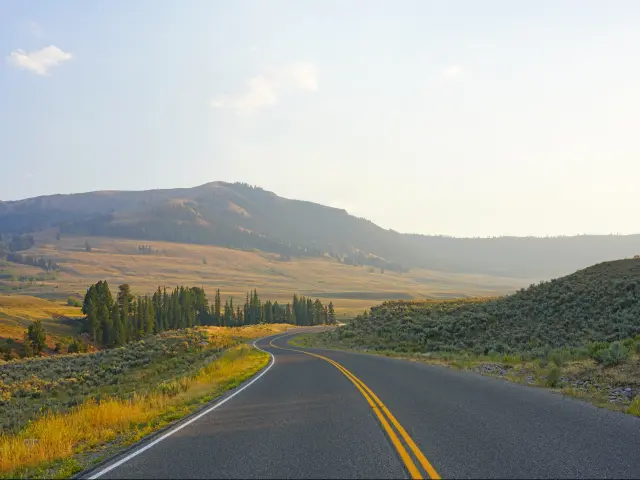
Penalties and dealing with the police
Hopefully you will never have the need to deal with the police or commit any traffic violations while you are in Wyoming, but just to make sure I thought, I'd add a few points for you keep in mind.
Don't drink and drive
The most obvious piece of advice about driving in Wyoming relates to drinking. Driving under influence (DUI) is an extremely serious offense and I would urge you to be extremely careful not to put yourself in a situation where you could be breaking the law.
Wyoming law has set the bar at a blood alcohol concentration of 0.08% - a relatively common level in the United States and similar to many other countries.
You can also be charged with DUI if the officer deems you to be clearly intoxicated without conducting a test.
Remember that the laws in Wyoming and the United States regarding DUI are pretty strict. You can be charged if you are in charge of the vehicle whether or not you are driving. If you are over the limit and are parked off the road with the engine off, you can still be done for DUI.
Also take care to not have any opened/unsealed alcohol in the vehicle. Whether or not you have drunk any, it is an offense with very stiff penalties. If you've been to a restaurant and are transporting an unfinished bottle of wine back with you, carry it in the trunk.
Some restaurants may be able to reseal the bottle and place it in a tamper-proof bag that also contains the receipt, but I'd wager that you will struggle to find a restaurant in Wyoming that has these bags readily available.
If you get stopped by the police
If you're driving along and a police officer indicates for you to stop or turns on their blue lights, find a safe place and pull over.
The following is not legal advice but if you want things to go smoothly, be polite and courteous, do exactly what the police officer tells you to do and answer questions properly.
There's a lot of people who will tell you otherwise, but in my experience if you have nothing to hide and want to be on your way quickly, pull over, pull down your window, switch off the the engine and place both hands on the steering wheel. Always confirm with the officer if you are going to reach into pockets or concealed parts of the car to get any paperwork out and be honest - you'll usually be on your way promptly.
If you've committed a traffic offense, in most cases you will get a fine and unless you're planning to go to court to contest it, just make sure you pay it before the due date and in any case before your leave Wyoming.
Parking in Wyoming
Unlike many places in the U.S., parking rules in Wyoming are pretty straight-forward.
Make sure you do the obvious - don't park in restricted areas, in front of driveways or near junctions. Check for signs - most of the time parking will be free. Some cities will have time-based restrictions of a few hours and sometimes you can park for as long as 3 days.
Some cities in Wyoming including Jackson have free parking lots where you can park for longer if you're coming to stay.
Remember that in the winter, some cities prohibit all parking on the streets overnight to help with clearing the snow so make sure you move your vehicle or it will get towed.
Renting a car in Wyoming
Renting a car in Wyoming is simple enough whether you're flying in or want to get a car for a weekend road trip.
If you're coming from outside the U.S., it's a good idea to have an International Driving Permit alongside your license. Although it's not compulsory, you might come across a less than co-operative person on the rental desk if you don't bring one.
Book your car ahead of time online to avoid disappointment and get the best rate. Remember that most car rental companies in Wyoming will only rent cars to over-25s. Some will go as low as 21 although you'll have to pay a hefty premium.
Your rental company will give you the necessary paperwork when you're picking the car up, but check if you'll need any extras and book them in advance to save time and money. If you think you may need snow chains or a child seat, most rental companies can provide these for an extra fee.
Things you need to have in the car
Unlike many other countries and some other states, you don't have to carry much in your car other than legal paperwork.
There is no requirement to have a medical kit, breathalyzers, a fire extinguisher or spare bulbs. The only thing you legally have to have in the car is a warning triangle that you can place a safe distance behind your car if you happen to break down.
Having said that, I'd highly recommend packing a spare light bulb set if you're driving your own car in case any of your lights go out 50 miles from the nearest town.
Technical car requirements
There isn't much that is unusual about Wyoming's requirements for vehicles to be road-legal.
All the standard clauses apply - your tires have to be in good condition and have at least two thirty-seconds (2/32) of an inch in tread depth (1.6 mm) - most tire wear indicators are set to this level so it should be easy to check.
Although unlike some other countries, regular vehicle inspections are not mandatory, it's a good idea to do at least a visual check of things like your brakes, suspension and make sure your liquids are all at correct levels before you set off.
Driving in different seasons and weather conditions
Wyoming has a varied landscape and varying weather that changes a lot between seasons. Whenever you're traveling to Wyoming, you need to make sure you pay attention to the conditions and drive appropriately.
Driving in the winter and snow chains
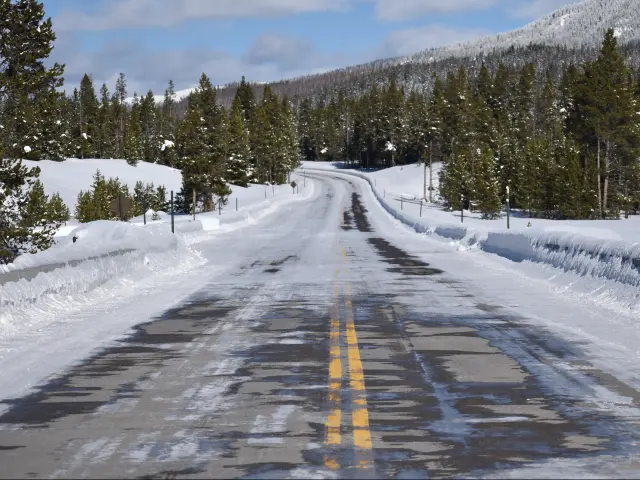
Snow tires are not compulsory in Wyoming despite the state being one of the snowiest in the United States. All season tires are a realistic minimum in the winter and snow tires are highly encouraged if you plan on driving anywhere near mountains.
There are some circumstances where snow tires can be a legal requirement - the state can declare some parts to be a Level 1 or a Level 2 restricted area.
For Level 1, your car has to have appropriate snow tires or be an AWD vehicle or use snow chains.
If the conditions are severe enough for Level 2, snow chains are compulsory on all vehicles except if you have an AWD car with winter tires. Even if you do, snow chains can be a good idea for safety.
If you are hiring a car in the winter and driving to places where you might need them, it is a good idea to pay to rent snow chains too. Although Yellowstone and some other areas are closed off, there are still plenty of remote places in Wyoming where you can get stuck in the snow.
If you're anticipating getting out and about in the middle of the winter, think about packing a few extra things into the car. A snow shovel, windshield scraper and tow rope can be very handy and pack warm clothes, blankets, food and drink in case you get stuck anywhere!
Also make sure you check your route - many roads are closed to regular vehicles over the winter season including most in and around Yellowstone.
Driving in adverse conditions
Aside from the requirements for driving in the snow, make sure you're prepared for different road conditions whenever you're driving around Wyoming. The state is huge and you might be setting off on a bright sunny warm day from Cheyenne and find a storm when you reach Yellowstone.
It is always a good idea to be prepared and take care. Specifically:
- Check your tires and windshield wipers to make sure they are in good condition
- Slow down and keep extra distance to the car in front - whether it's icy and slippery in the winter or wet in the fall and spring, there are lots of reasons why you might need the extra space.
- Turn on your lights at any time - lights make it easier to spot you. If you're coming round a narrow mountain road bend or pulling out from behind a corner, lights can only make you more visible.
- Be smart with braking and never push the brake pedal to the floor. Skidding over an icy/wet/slippery/loose surface is where a lot of trouble starts so be careful when you need to slow down.

